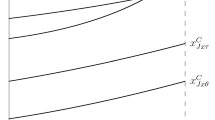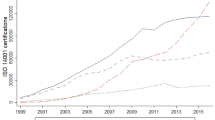Abstract
Several firms have recently supported their countries’ participation in international environmental agreements where countries commit to stricter environmental regulation. This paper analyzes the rationale of this conduct by examining equilibrium emission standards with and without environmental treaties. We identify that more stringent environmental regulation produces two effects on firm profits: a negative effect due to larger abatement costs, and a positive effect that arises from the amelioration of duopoly overproduction. We describe under which conditions the positive effect dominates the negative effect, increasing firm profits, and inducing them to support their countries’ participation in environmental treaties.
Similar content being viewed by others
References
Barrett S. (1994) Strategic environmental policy and international trade. Journal of Public Economics 54: 325–338
Conrad K. (1993) Taxes and subsidies for pollution-intensive industries as trade policy. Journal of Environmental Economics and Management 25: 121–135
Farzin Y. H. (2003) The effects of emission standards on industry. Journal of Regulatory Economics 24: 315–327
Feenstra T., De Zeeuw A., Kort P. M. (2003) International competition and investment in abatement: Taxes versus standards. In: Marsiliani L., Rauscher M., Withagen C. (Eds.), Environmental economics and the international economy. Kluwer Academic Publishers, Dordrecht
Kennedy P. (1994) Equilibrium pollution taxes in open economies with imperfect competition. Journal of Environmental Economics and Management 27: 49–63
Markusen, J., Morey, E., & Olewiler, N. (1992). Noncooperative equilibria in regional environmental policies when plant locations are endogenous. NBER Working Paper 4051.
Markusen J., Morey E., Olewiler N. (1993) Environmental policy when market structure and plant locations are endogenous. Journal of Environmental Economics and Management 24: 69–86
Porter M. E. (1991) America’s green strategy. Scientific American 264: 168
Porter M. E., van der Linde C. (1995) Green and competitive: Breaking the stalemate. Harvard Business Review 73: 120–134
Porter M. E., van der Linde C. (1995b) Toward a new conception of the environment-competitiveness relationship. Journal of Economic Perspectives 9(4): 97–118
Rauscher, M. (1993). Environmental regulation and international capital allocation. Nota di Lavoro 79.93. Milan: FEEM.
Ulph A. (1994) Environmental policy, plant location and government protection. In: Carraro C. (Ed.), Trade, innovation, environment. Kluwer Academic Publishers, Dordrecht
Ulph A. (1996a) Environmental policy and international trade when governments and producers act strategically. Journal of Environmental Economics and Management 30: 265–281
Ulph A. (1996b) Strategic environmental policy, international trade and the single European market. In: Braden J., Folmer H., Ulen T. (Eds.), Environmental policy with economic and political integration: The European community and the United States. Edward Elgar, Cheltenham
Author information
Authors and Affiliations
Corresponding author
Additional information
A previous version of this paper was circulated under the title “A Tale of Two Externalities: Environmental Policy and Market Structure.”
Rights and permissions
About this article
Cite this article
Espínola-Arredondo, A., Muñoz-García, F. When do firms support environmental agreements?. J Regul Econ 41, 380–401 (2012). https://doi.org/10.1007/s11149-011-9170-3
Published:
Issue Date:
DOI: https://doi.org/10.1007/s11149-011-9170-3
Keywords
- Transboundary pollution
- Strategic environmental policy
- International environmental agreement
- Market structure




